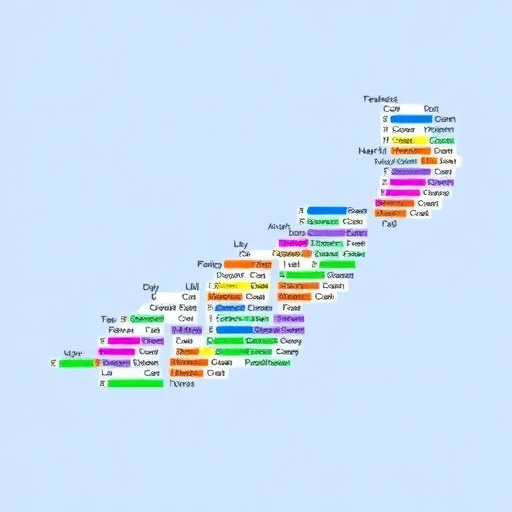In the intricate world of genomics, understanding the mechanisms of gene regulation is paramount. One fascinating aspect of this field is the methylation of CpG islands, which play a crucial role in the modulation of gene expression. Recent groundbreaking research conducted by Abdullaev, Haridoss, and Arndt sheds light on this subject by employing innovative computational methods to predict the methylation status of these critical genomic regions. This study, published in BMC Genomics, represents a significant stride towards unraveling the complexities of epigenetic regulation.
Methylation, particularly at CpG dinucleotides, is a well-studied epigenetic modification influencing a variety of biological processes, including development, differentiation, and disease progression. CpG islands are regions that are often rich in cytosine and guanine nucleotides, and their methylation state can determine whether specific genes are expressed or silenced. This regulation is essential for normal cellular functions and has profound implications in oncogenesis, where aberrant methylation patterns can lead to tumorigenesis.
The researchers employed advanced statistical and machine learning techniques to probe the relationship between the distribution of sequencing reads and the methylation status of CpG islands. Traditional methods of evaluating methylation often involve expensive and time-consuming bisulfite sequencing; however, the novel approach proposed in this study exploits read distribution biases, offering a cost-effective alternative that can be rapidly deployed in various genomic studies.
By utilizing large datasets from previous whole-genome sequencing efforts, the authors built a predictive model that significantly improves accuracy in identifying methylation patterns. They meticulously designed their methodology to account for the potential biases introduced during amplification and sequencing processes, which are often overlooked in conventional analyses. As a result, their model can provide more reliable estimations of the methylation status than traditional methods.
The implications of this research extend beyond mere prediction. By enabling a deeper understanding of the methylation landscape of CpG islands, this study lays the groundwork for future explorations into the epigenetic mechanisms underlying complex diseases, including various cancers. Identifying specific methylation patterns associated with disease states could lead to breakthroughs in diagnostic biomarker development and therapeutic interventions.
Furthermore, the method developed in this research is versatility incarnate, with applications not only in cancer research but also in developmental biology and regenerative medicine. Scholars in these fields can leverage these insights to investigate how methylation influences cell fate decisions, tissue regeneration, and the aging process. The potential applications seem limitless, opening avenues for innovative research and discoveries.
As we venture further into an era of big data in genomics, tools such as the one presented by Abdullaev and colleagues provide an essential platform for integrating vast amounts of biological data. The ability to predict methylation patterns with high accuracy will undoubtedly enhance our understanding of gene regulation and its impact across different biological contexts. This advancement heralds a new age in genomics where computational predictions are not merely supplementary but pivotal in shaping experimental designs.
Moreover, the authors emphasize the importance of collaborative efforts among genomic researchers. The continual sharing of data and methodologies can accelerate the pace of discoveries in the ever-evolving landscape of genomics. As predicting methylation patterns becomes increasingly accessible, it invites not only genomic experts but also scientists from adjacent disciplines to participate in interdisciplinary research efforts.
In summary, the predictive model developed by Abdullaev, Haridoss, and Arndt represents a seminal contribution to the field of genomics, particularly in understanding the methylation status of CpG islands. The research underscores the significance of computational approaches in deciphering the complexities of the epigenome and highlights the potential ramifications for various biological and medical fields. This groundbreaking work invites further exploration and sets the stage for transformative discoveries in our understanding of gene expression regulation.
As the scientific community continues to grapple with the intricacies of epigenetics, this study serves as a beacon of progress, inviting researchers to leverage these insights and explore the profound implications of methylation dynamics in health and disease. With ongoing developments in sequencing technologies and data analysis, the potential to decode the mysteries of the genome remains within reach, encouraging bold ideas and innovative strategies that can shape the future of biomedical research.
In conclusion, the study by Abdullaev and his team not only contributes a powerful new tool for the analysis of methylation status but also stimulates a broader dialogue on the importance of integrating emerging technologies into genetic research. As we move forward, the collaborative spirit and readiness to embrace new methodologies will be crucial in unlocking the secrets that the genome holds, ultimately advancing our pursuit of personalized medicine and effective therapeutic strategies.
Subject of Research: Methylation status prediction of CpG islands
Article Title: Predicting the methylation status of CpG islands from read distribution biases
Article References:
Abdullaev, E.T., Haridoss, D.A. & Arndt, P.F. Predicting the methylation status of CpG islands from read distribution biases.
BMC Genomics 26, 973 (2025). https://doi.org/10.1186/s12864-025-12257-7
Image Credits: AI Generated
DOI: 10.1186/s12864-025-12257-7
Keywords: Methylation, CpG Islands, Gene Regulation, Epigenetics, Machine Learning, Genomics, Biomarkers, Cancer Research, Predictive Modeling, Data Analysis.




